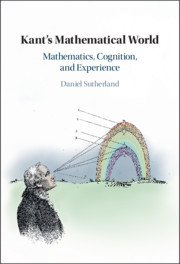Book contents
- Kant’s Mathematical World
- Kant’s Mathematical World
- Copyright page
- Dedication
- Contents
- Preface and Acknowledgments
- 1 Introduction
- Part I Mathematics, Magnitudes, and the Conditions of Experience
- Interlude The Greek Mathematical Tradition as Background to Kant
- Part II Kant’s Theory of Magnitudes, Intuition, and Measurement
- 7 Kant’s Reworking of the Theory of Magnitudes
- 8 Kant’s Revision of the Metaphysics of Quantity
- 9 From Mereology to Mathematics
- 10 Concluding Remarks
- Bibliography
- Index
7 - Kant’s Reworking of the Theory of Magnitudes
Homogeneity and the Role of Intuition
from Part II - Kant’s Theory of Magnitudes, Intuition, and Measurement
Published online by Cambridge University Press: 21 October 2021
- Kant’s Mathematical World
- Kant’s Mathematical World
- Copyright page
- Dedication
- Contents
- Preface and Acknowledgments
- 1 Introduction
- Part I Mathematics, Magnitudes, and the Conditions of Experience
- Interlude The Greek Mathematical Tradition as Background to Kant
- Part II Kant’s Theory of Magnitudes, Intuition, and Measurement
- 7 Kant’s Reworking of the Theory of Magnitudes
- 8 Kant’s Revision of the Metaphysics of Quantity
- 9 From Mereology to Mathematics
- 10 Concluding Remarks
- Bibliography
- Index
Summary
Chapter 7 returns to Kant for a deeper analysis of his views and their relation to the Euclidean mathematical tradition. Chapter 6 revealed that Euclid defined neither magnitude nor homogeneity, so that these notions are at best implicitly defined by the Euclidean-Eudoxian theory of proportions. Kant reworks the Euclidean theory of magnitudes, defining magnitude in terms of his own understanding of homogeneity, which admits of no qualitative difference of the manifold and which I call strict homogeneity. Most importantly, he thinks that intuition is required to represent either a continuous or a discrete manifold without qualitative difference. This role for intuition in Kant’s philosophy of mathematics and experience has not been appreciated, but finds support in various texts, especially Kant’s lectures on metaphysics and his criticisms of Leibniz’s views in the Amphiboly. Given Kant’s understanding of qualities, differences in dimension correspond to qualitative differences, so that Kant’s account corresponds to Euclid’s understanding of homogeneous magnitudes. Understanding the role of intuition allows us to appreciate the role of the categories of quantity and intuition in part–whole relations and the composition of magnitudes. The chapter closes with clarifying the sense in which intuition is required for the representation of magnitudes.
Keywords
- Type
- Chapter
- Information
- Kant's Mathematical WorldMathematics, Cognition, and Experience, pp. 197 - 218Publisher: Cambridge University PressPrint publication year: 2021

